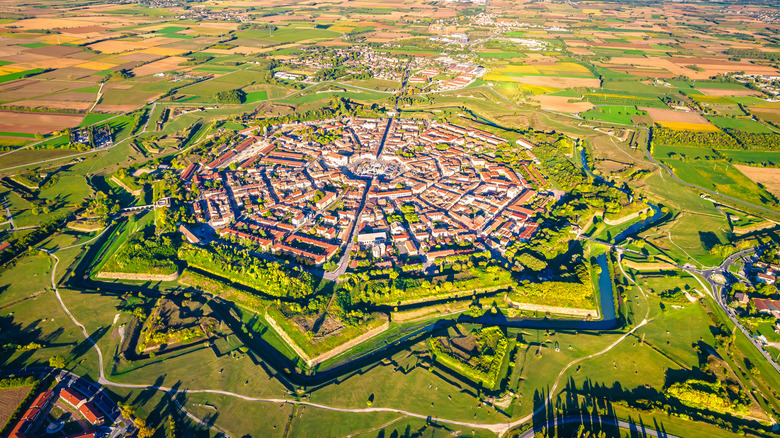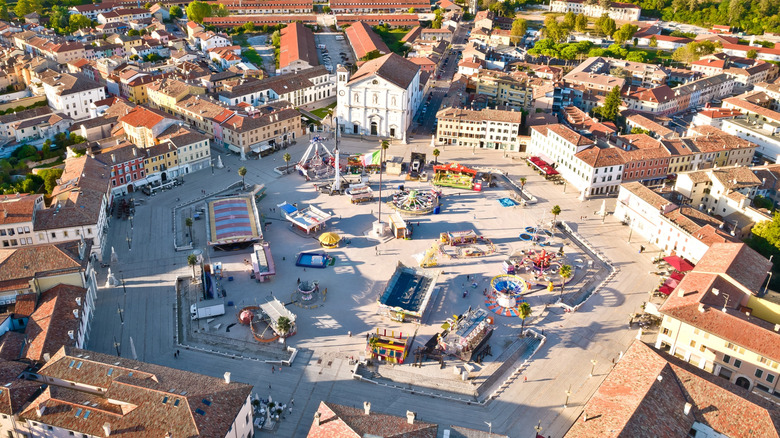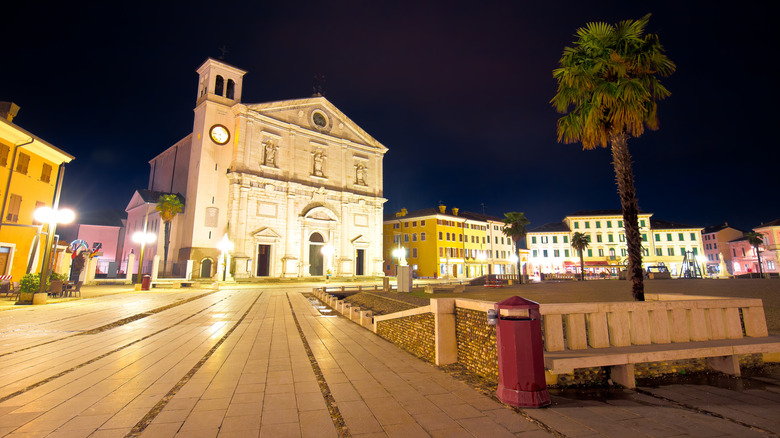Italy's Underrated Fortress Town Best Known As 'Star City' Is A Charming Masterpiece Of Design
A global maritime power and trading hub for eons, Venice has quite the storied past and is a great destination for history buffs. But there's a lesser-known Italian city just over an hour northeast that military history buffs in particular will find fascinating: Palmanova. Built as a fortress city in the shape of a perfectly symmetrical nine-point star, Palmanova exemplifies Renaissance-era military architecture and has been a UNESCO World Heritage Site since 2017.
During the Renaissance, in the 15th and 16th centuries, the Venetian Republic created the fortress city to protect against potential aggressors, mainly the Hapsburgs and the Turks. Meticulously planning each detail of the design, the Venetians dug a moat around the star-shaped "fortressa" and planted trees to hide it from passersby. The only entrance points were three heavily guarded gates — named Aquileia, Udine and Cividale — from which three main roads led to a hexagonal center, the Piazza Grande. Between 1806 and 1813, the occupying French under Napolean added another layer of fortifications around the town. Spanning more than 200 years from start to finish, the construction of Palmanova was one of many centuries-long European building projects.
Palmanova: a failed utopia?
The town's founders hoped that besides ensuring safety, Palmanova would provide its inhabitants with an exceptionally high quality of life. Its main physical features — the nine-pointed star, the three gates, the six main roads, and the 18 radial roads — were all in multiples of three. In line with Renaissance philosopher Thomas More's vision of Utopia, the design's symmetry was intended to aesthetically soothe residents, enhancing their peace of mind. It was also hoped that the uniformity of the design would foster equality, with all houses the same color, size, and style to eliminate any need for envy.
Utopia or not, after Palmanova was erected, the Venetian Republic could not populate the walled city. This isn't surprising when you think about Italy. The town's planned precision must have felt bland to those used to living in Italy's colorful chaos: Towns with zigzagging streets lined with a dazzling mix of buildings, maybe even a few pieces of garbage here and there, nothing working as it should, but all summing up to something strangely glorious. Eventually, to convince people to live in perfect Palmanova, the government devised a scheme of pardoning criminals and offering them free property.
Exploring the star-shaped city
The population of today's Palmanova hovers around 5,300. It remains a small city by anyone's estimation but is nonetheless a fascinating place to visit. A visit to Palamanova is a perfect day trip from Venice (70 miles away) or Trieste (33 miles away), home of Europe's largest waterfront square, with regular train service between all three cities.
Begin exploring on foot or on a bicycle on one of the footpaths outside the town walls to see the extent and ingenuity of all the different fortifications. It's free to walk or cycle around the perimeter but for a few euros, it's also possible to enter an underground tunnel and a bastion. Next, walk through one of the massive gates, which are impressive all by themselves. Those interested in the area's military history from the late 16th century to today should visit the War and History Museum of Palmanova, which comprises three areas in and around one of the main gates, the Porta Cividale.
Then take one of the main roads toward the lovely historic center, Piazza Grande. One striking structure in the hexagonal piazza is the 16th-century Palmanova Cathedral, with its classic Venetian architecture and bell tower that was built very low to be less vulnerable to attacking forces. This piazza is also where the town holds a number of vibrant festivals and historic reenactments, like the A.D. 1615 Palma to Arms the first weekend in September, which could be fascinating to attend if you time your visit just right.


